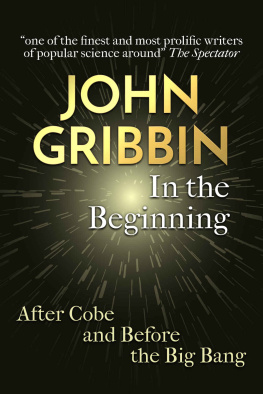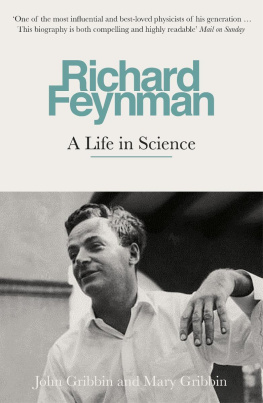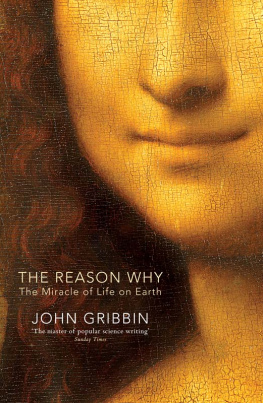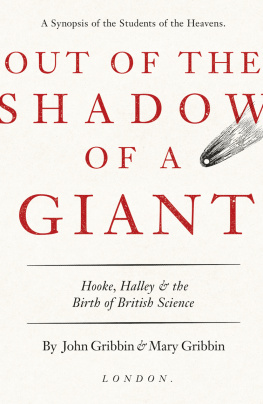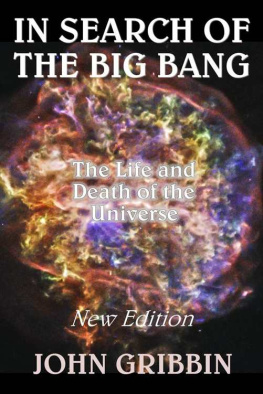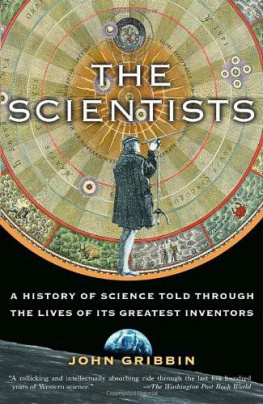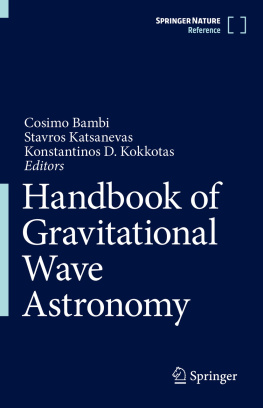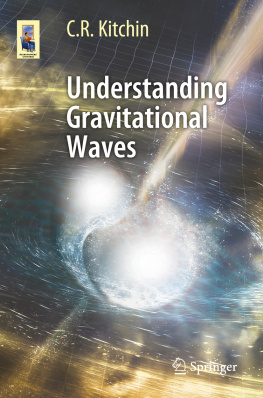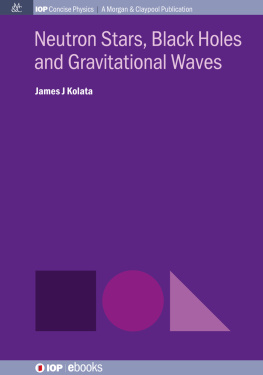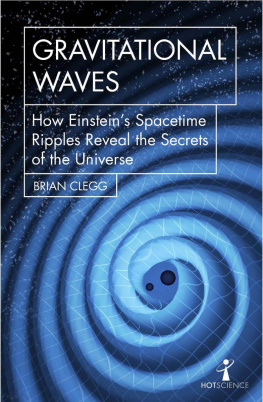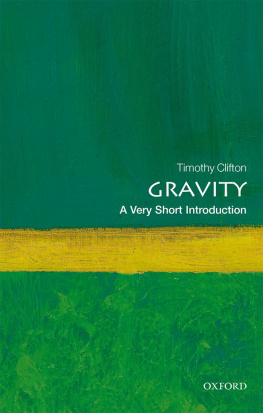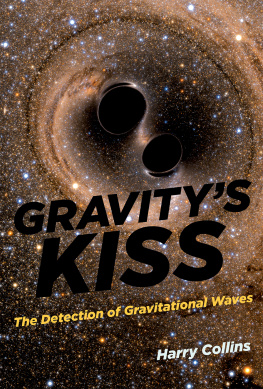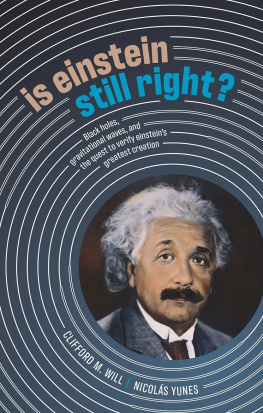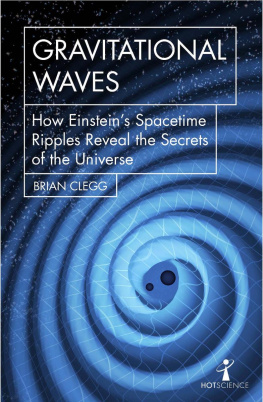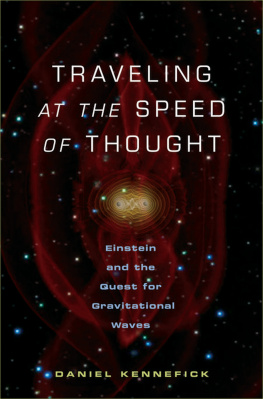Discovering Gravitational Waves
John Gribbin
Copyright 2017 by John Gribbin
Introduction
In February 2016, a team of researchers working at the Laser Interferometer Gravitational-wave Observatory (LIGO) in North America reported that they had made a direct detection of gravitational waves ripples in space produced by the collision of two black holes far away across the Universe. This extraordinary experiment measures ripples much smaller than the size of an atom, and ranks as one of the most successful achievements in the whole of science. In one sense, the discovery was beautifully timed, coming exactly a hundred years after the publication of the scientific papers in which Albert Einstein, with his general theory of relativity, explained gravity in terms of distortions in spacetime. But in another sense, the announcement was ill-timed. Nominations for the Nobel Prizes close each year on 1 February, so the team were a couple of weeks too late to be considered for the 2016 Physics Prize. It is, though, impossible to think of a more worthy contender for the 2017 Prize. In this essay, I want to explain why the discovery is so important, and fill in the background to the story, starting with Einsteins masterpiece, completed at the end of 1915 and published in all its glory in 1916.
From Doubt to Certainty
Einstein did not mention gravitational waves in his great paper on the general theory but he had been thinking about them for several years because of the question of how fast a gravitational influence reaches out across the Universe. We can look at this in terms of the way the presence of any object that has mass distorts space around it (it distorts space and time, spacetime, but space is the bit we are interested in). The classic example (skip this if you know it) is to think of space as like a stretched rubber sheet, or the surface of a trampoline, and represent a mass like the Sun as a bowling ball plonked on the trampoline. The ball makes a dent on the trampoline, and marbles rolled across the surface follow curved lines (trajectories) around the dent. Similarly, the curved space around a massive object such as the Sun makes objects follow curved trajectories near it; we see this as a result of a force, which we call gravity. Even light is affected in this way, and it was Einsteins prediction of how much starlight would be bent as it passed near the Sun that enabled astronomers to test his ideas during a solar eclipse in 1919. The theory passed the test with flying colours, and Einstein became famous.
But what if the bowling ball is taken away? The curved surface of the trampoline becomes flat again, but it doesnt do so instantly. The smoothing out spreads across the surface. The Earth is following an orbit around the Sun because of the dent the Sun makes in spacetime. I have to be careful here not to say that it is just a dent in space; the situation is a bit more complicated than the bowling ball analogy, but I shall spare you the details. If the Sun suddenly ceased to exist, would the Earth instantly fly free in space, or would the curve still be there for a while, at the distance of the Earth, holding the planet in its orbit until spacetime flattened itself out, and only letting it fly free when there had been time for the information that the Sun had gone to reach us? The best guess was that gravity must propagate in some way at the same speed as light. Light from the Sun takes just over 8 minutes to reach the Earth, so if the Sun were to go out, our sky would only go dark 8-and-a-bit minutes later. Since Einstein already knew, from the special theory he had published in 1905, that nothing could travel faster than light, he expected that gravity would travel at the same speed. So if the Sun disappeared, the Earth would continue in its orbit and the sky would be bright for another 8-and-a-bit minutes, then the sky would go dark and the planet would fly free at the same time.
But think again about that bowling ball being taken off a trampoline. The stretched surface doesnt instantly go back to being flat; it bounces up and down for a while as it settles down, sending ripples across the surface. If the Sun disappeared, the space (spacetime) around it would presumably ripple in the same way, with the ripples dying down while it smoothed out. These ripples would be gravitational waves.
Later in 1916, Einstein did publish a paper on gravitational radiation (in this context, the terms waves and radiation are interchangeable, but not gravitational and gravity; gravity waves are the waves made by a fluid, such as your bathwater, sloshing about under the influence of gravity). But even Einstein was fallible in fact, he was not very good at maths, by the standards of Nobel-prizewinning physicists and he made a mathematical mistake in that paper which led to a false conclusion which confused the issue. It took two years for his colleagues to convince him that he had indeed made a mistake, and for him to accept the correct description of the waves described by the general theory of relativity. So 1918 was really the year in which gravitational wave theory got off the ground. But unlike the light-bending prediction, there was no obvious way to test whether gravitational waves really existed. You cant make the Sun disappear to test the theory. Einstein himself was never quite sure if it was right. According to the theoretical cosmologist Janna Levin he once said, If you ask me whether there are gravitational waves or not, I must answer that I do not know. But it is a highly interesting problem. It would be nearly sixty years before all doubts about the reality of gravitational waves were removed by the discovery of an astronomical object known as the binary pulsar.
After an initial burst of attention for Einsteins theory following the success of the light-bending observations, the general theory became overshadowed by the success of the quantum theory developed in the 1920s and beyond. Quantum physics had practical implications in things such as chemistry, explaining how molecules work, and electronics, leading to the development of transistors and other solid state devices. But the general theory didnt seem to have any practical applications, and was largely left to mathematicians who enjoyed tinkering with the equations. The one area of science where it did apply was in cosmology, the investigation of the Universe at large, where it turned out that the equations of the general theory describe an expanding Universe exactly like the one revealed by observations of distant galaxies. But right up until the 1960s, and the discovery of the cosmic background radiation that is interpreted as the echo of the Big Bang, only a few people took these cosmological calculations seriously, and the ones who did argued about what they meant; there was even some uncertainty about just how general the general theory really was.. As late as 1966, when I told the cosmologist Herman Bondi that I wanted to study cosmology, he advised me that if I wanted to be taken seriously as a scientist I should study something more respectable first. Mathematicians loved it, but physicists, for the most part, just didnt bother with it. As for gravitational waves, like Einstein they thought them to represent an interesting problem to which nobody knew the answer.
The exception to the scepticism (if that is not too strong a word) about the general theory was a small band of scientists, astrophysicists who were interested in what happens to stars when they run out of fuel. In the prime of its life, a star keeps shining because deep in its heart the nuclei of lighter elements are being fused to make heavier elements hydrogen to make helium, helium to make carbon, and so on. At each stage, a little of the mass (m) involved is released as energy (E) in line with Einsteins famous equation (from the special theory),
Next page

